Eddie Bauer KARA KORAM 轻量羽绒睡袋赏析
Eddie Bauer是国内非常少见的品牌,在户外圈子里知道的人也并不多,反而倒是他的副牌FIRSTASCENT倒是有不少人买过他家的产品。事实上这个牌子可并不像我们看到的那么默默无闻,在黄金登山时代甚至早期,Eddie Bauer的羽绒制品就非常的出名,当然这里的羽绒制品主要是针对户外用途,这是一个地道的北美优秀的羽绒装备品牌,Eddie Bauer的Unconditional Guarantee of Satisfaction理念在当时非常的超前和有远见。虽然那个时代的很多装备品牌在品质上都有非常高的要求和标准,但是对于售后能够提供如此夸张的服务不是每个BOSS都能做到的。
Eddie Bauer早期是生产羽绒服装和睡袋制品,产品以结实耐用,轻量著名,在积累了足够的经验之后成为美国空军优质羽绒制品的供应商。这期间还有另外几个户外品牌也为美军提供优质装备。当然和民用装备有一些差异。
Eddie Bauer KARA KORAM是典型的早期轻量化装备的代表,无论是设计还是材料都代表了当时轻量化装备的巅峰水平。
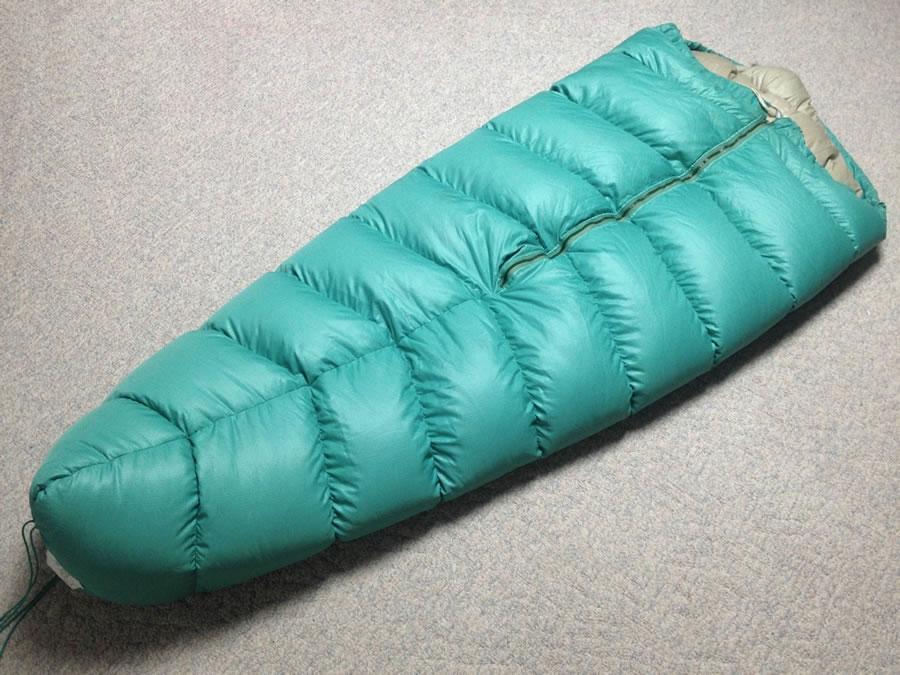
早期睡袋的结构很多都是这个类型,无法得知哪个品牌最先使用这种结构设计,但是这种设计应该是来源于更早期的北欧山地睡袋的款式。

这种三角形的外形设计基本符合人体外形,也是立体裁剪出现之前那个时代能够找到的最好的外形设计。
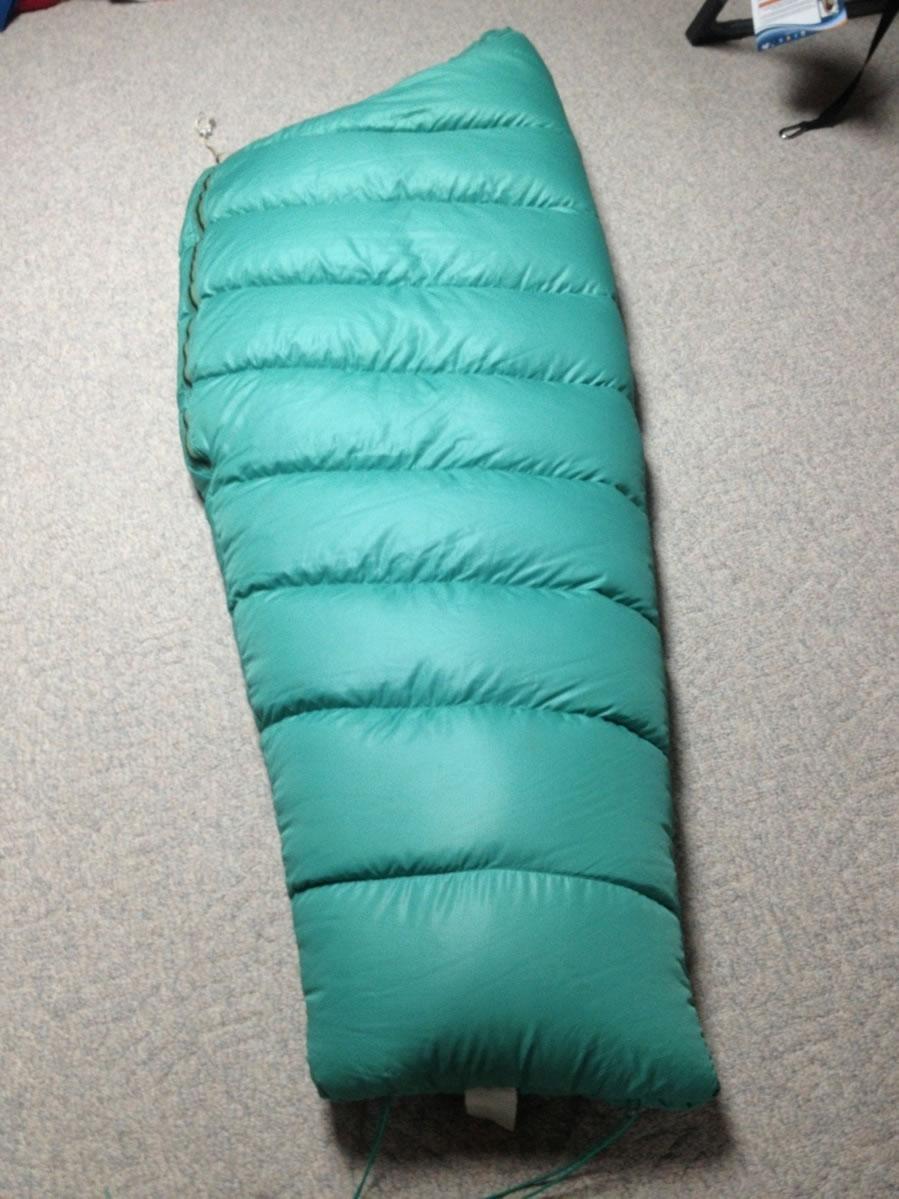
简单的说明书,但是这个说明书里介绍的东西可不简单,说明书中详细介绍了睡袋的使用,保养,甚至是睡袋的技术资料,W型的立衬结构即便是今天也是非常优秀的设计,实际上睡袋的立体结构到今天100年的变化中没有任何进步,这也不知道算是可喜还是可忧。
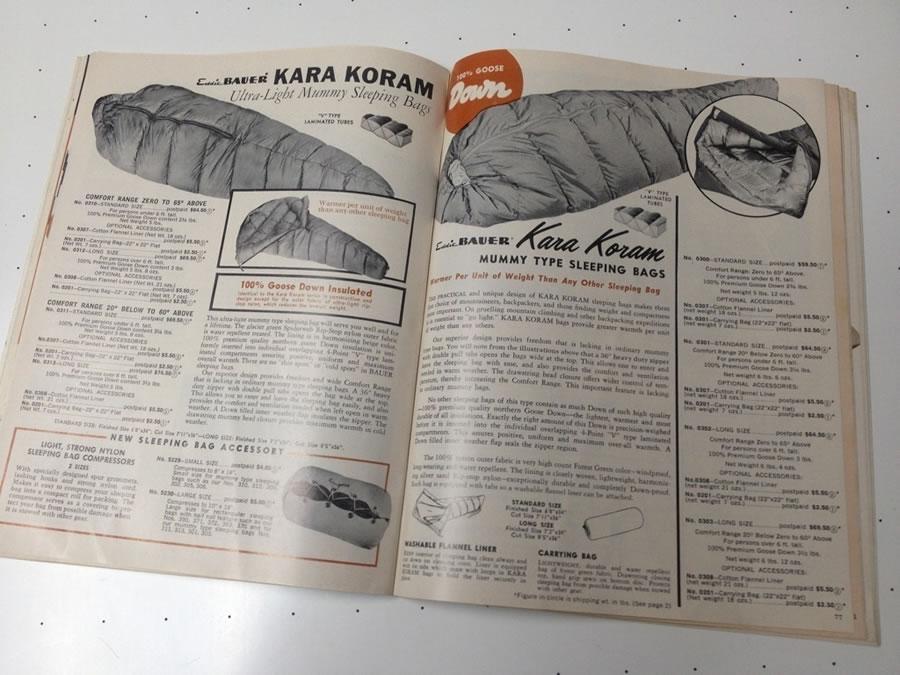
标签上的Blizzard PROOF,说明这条睡袋是的功能性很强,至于是不是能够抵抗Blizzard,额! 这个我没有体验过。但是当时尼龙防水外层的使用,使得装备在轻量化和防水等功能性上有了长足的进步。

做工其实是比较粗糙的,相对于现在的工艺而言。在黄金登山时代北美的产品做工普遍的粗糙是显而易见的,相对而言欧洲的一些知名品牌的工艺稍微好一些,但是也强不了太多,可能和那个时代的人们对于产品的理解上和今天不太一样,那个时代的装备侧重点不在商业噱头而在使用价值和功能性的展现上。
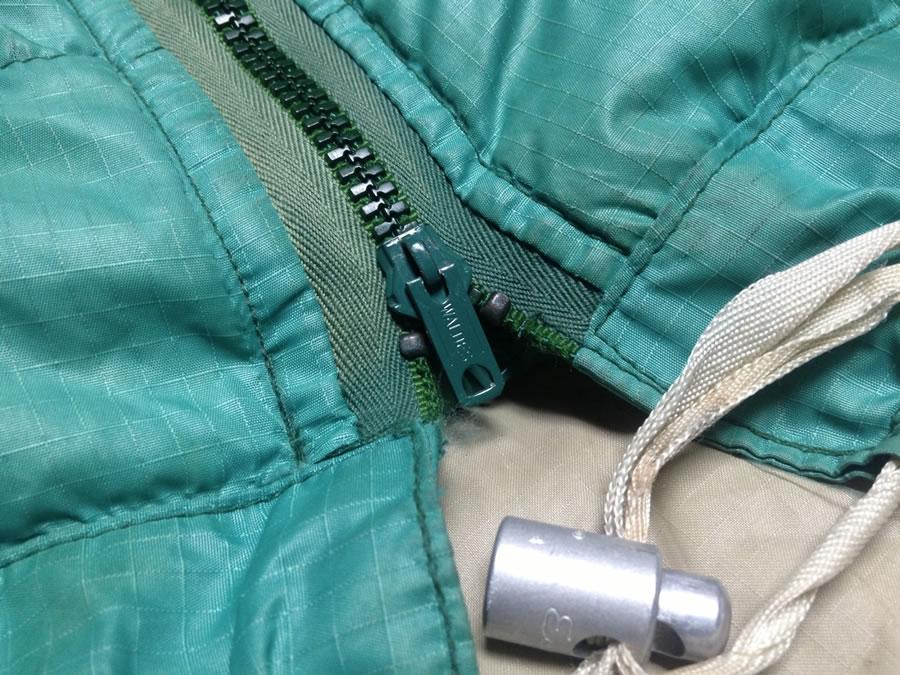
填充了3磅多的灰鹅绒,差不多是现在1500克羽绒睡袋的级别,也就是说可以在零下30度保持舒适睡眠。

Eddie Bauer的睡袋品质很高也出了很多精品和有代表性的产品,另一款模块化的四季羽绒睡袋就是其中一个代表作。通过两天睡袋的组合使用可以涵盖从春天到冬天各种温度环境下的户外使用。同时这款模块化的睡袋也是早期轻量化产品的代表作品,两条睡袋都没有使用沉重的拉链,只是通过颈部的抽绳来调节。在尺寸上两条睡袋也设计的相当和谐,蓝色低温睡袋有头袋,可以通过调节完全覆盖人体,黄色睡袋的长度刚刚覆盖人体的躯干,单独使用正好是春夏季节的最佳长度。
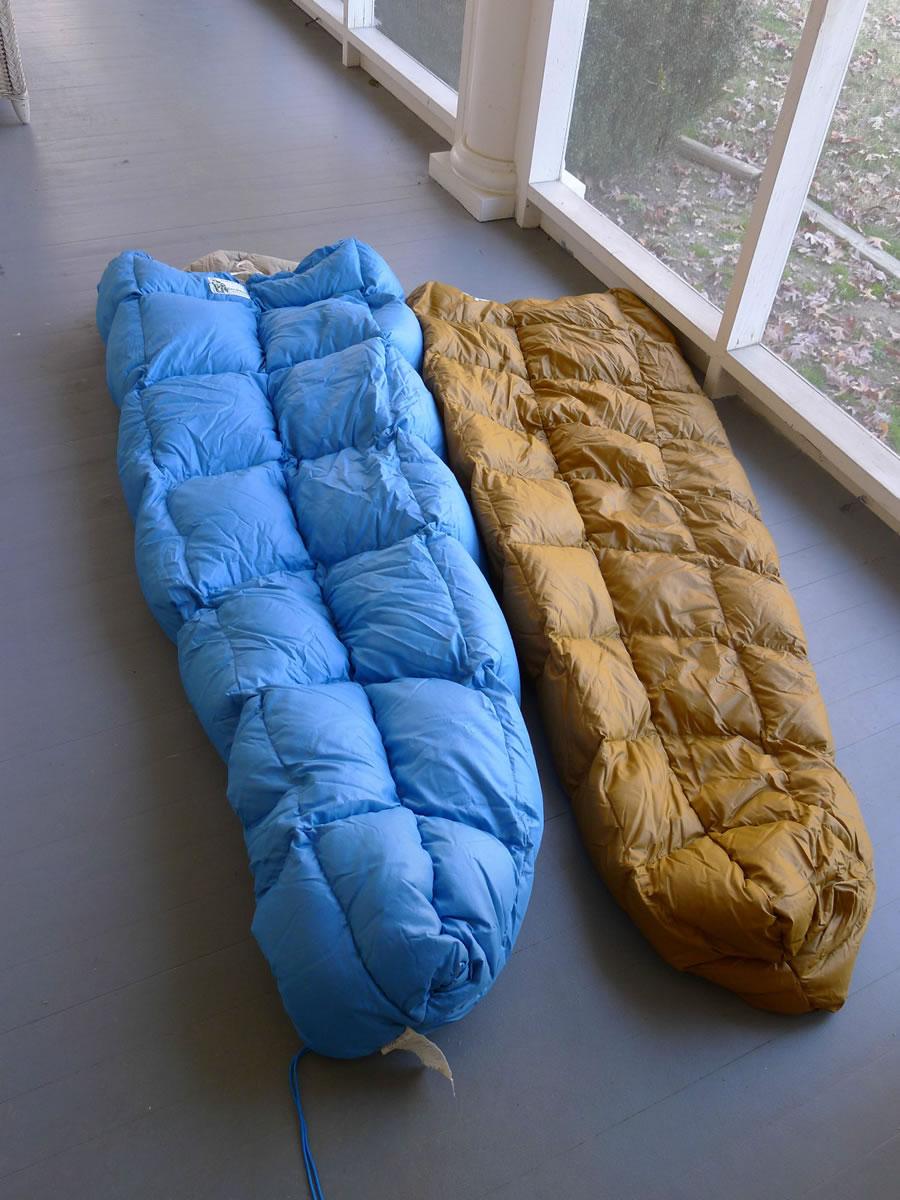
图腾化的品牌LOGO也是极富有视觉冲击效果

深入阅读:
公司理念:
Our Creed: To give you such outstanding quality, value, service and guarantee that we may be worthy of your high esteem. –Eddie Bauer, 1920 Key Dates:
重要年份极其事件:
1920:
Eddie Bauer opens Eddie Bauer“s Sport Shop in Seattle.
1922:
Bauer begins offering his customers an unconditional guarantee of satisfaction.
1924:
Store is renamed Eddie Bauer“s Sporting Goods.
1936:
Bauer patents and introduces the first goose down insulated jacket, marking the company“s entrance into outdoor apparel.
1942:
Bauer begins providing goose down products to the U.S. Army Air Corps.
1945:
Company sends out its first mail-order catalogs.
1953:
Company is reorganized as a 50–50 partnership between Eddie Bauer and William F. Niemi, Sr., under the name William F. Niemi Co., doing business as Eddie Bauer Expedition Outfitters.
1968:
Bauer retires, selling his interest in the company to Niemi; the company is incorporated as Eddie Bauer, Inc.
1971:
General Mills, Inc. acquires Eddie Bauer for $10 million.
1984:
Through a licensing deal with Ford, the first Eddie Bauer edition SUV makes its debut.
1988:
Spiegel, Inc. acquires the company for $260 million.
1991:
Eddie Bauer Home makes its debut.
1993:
Company enters into joint venture to open stores and start catalog operations in Japan.
1995:
Joint venture is created to form retailing and cataloging operations in Germany.
1996:
Company moves into e-commerce with the launch of eddiebauer.com.
2000:
With expansion into Hawaii, there are now Eddie Bauer stores in all 50 states.
公司历史:
Eddie Bauer, Inc. is a catalog, storefront, and e-commerce retailer through two concepts: Eddie Bauer Sportswear, which offers outdoor apparel, sportswear, and accessories; and Eddie Bauer Home, which features bedding, home furnishings, and decor. The company mails out 110 million catalogs per year, with about a quarter of revenues stemming from catalog and web site orders.
On the storefront side, there are 430 Eddie Bauer sportswear stores in North America and 38 Eddie Bauer Home units in the United States. To clear excess merchandise, the company runs an additional 52 Eddie Bauer Outlet stores in the United States, as well as the eddiebaueroutlet.com web site. The company is a wholly owned subsidiary of catalog retailer Spiegel, Inc., which in turn is controlled by Germany“s Otto family, majority owners and operators of Otto Versand GmbH & Co., the world“s largest mail-order firm.
Through joint ventures with units of Otto Versand, Eddie Bauer operates retail outlets and distributes catalogs in Japan and Germany and has a cataloging only venture in the United Kingdom. The company also licenses the Eddie Bauer brand to several other companies, including Ford Motor Company, which has made Eddie Bauer edition sport-utility vehicles since 1984; the Lane Company, for a line of Eddie Bauer furniture; and Cosco, Inc., which sells Eddie Bauer car seats.
早期历史
Created by the son of Russian immigrants, Eddie Bauer, Inc. began as a tennis racquet stringing business in Seattle, Washington. While his parents would eventually play a significant role in the development of Eddie Bauer, Inc., Eddie Bauer initially drew upon his childhood years on Orcas Island, a sparsely populated island near Seattle, as the inspiration for what eventually would become a billion-dollar retail business.
Those early years were spent fishing, hunting, and trapping on the wooded island, imbuing Bauer with a love of the outdoors. When his family moved to Seattle in 1912, Bauer was 13 years old and looking for work. He immediately gravitated toward the only full-line sporting goods store in the city, Piper & Taft, and landed a job as a stock boy.
Over the years, Bauer watched and learned, eventually becoming adept at making guns, fly rods, and golf clubs. In addition to these talents, Bauer also developed considerable skill in stringing tennis racquets, winning the world speed championship, while in a display window at Piper & Taft, by stringing 12 racquets in slightly more than three and a half hours. Still in his teens, Bauer already had gained the attention of Seattle“s sporting community.
He often was referred to in local newspapers for killing the biggest elk, or catching the most fish, or for winning rifle- and pistol-shooting competitions. This local recognition would serve Bauer well when, in 1919, with $25 in his pocket and $500 borrowed on a 120-day loan, he rented 15 feet of wall space in a gun shop for $15 a month and began stringing racquets on his own. In this venture, Bauer enjoyed immediate success, stringing enough racquets to accumulate $10,000 within his first year.
Encouraged by his initial success, Bauer arranged for credit from a bank and opened his own shop, Eddie Bauer“s Sport Shop, in 1920, the predecessor of Eddie Bauer, Inc.
In addition to his renowned racquet-stringing abilities, Bauer also offered golf equipment and trout fishing flies during his first year of business, and the 20-foot storefront quickly became a haven for sporting enthusiasts throughout the Pacific Northwest. Bauer“s success during these nascent years was in large part due to his reputation as an experienced outdoorsman and his active participation in the sporting community. He worked at his store from February through August each year, then hunted and fished throughout the winter. During these sojourns in the wild, he field tested all of the equipment he sold in his stores, which, after the first year, included an array of outdoor equipment and clothing. Two years after he opened for business, this firsthand knowledge of his stock enabled him to offer an unconditional guarantee of satisfaction on all of the products sold in his store, a rarity for retail businesses during the 1920s; he also established a company creed.
Bauer promoted sporting activities in his spare time, increasing the public“s awareness of such sports as skiing by importing Norwegian hickory skis and persuading Norwegian skiers to come to the Pacific Northwest to help foster growth in the sport.
By 1924, Bauer had added a complete selection of fishing tackle, firearms, and skeet and trap equipment to his store and renamed it Eddie Bauer“s Sporting Goods. Customers continued to flock to Bauer“s store, lured by his unconditional guarantee and his knowledge of the outdoors. Eddie Bauer“s Sporting Goods had quickly become a favorite place for outdoorsmen to outfit themselves for a wide variety of sporting endeavors.
With a large and loyal clientele, Bauer“s future success appeared as guaranteed as the products he sold, but, in the coming years, Bauer“s position as a successful operator of a local sporting goods store would be elevated to a height not imagined even during the optimistic 1920s.
1930s: From Shuttlecocks to Goose Down Jackets
Bauer“s success had been predicated on his experience and interest in sporting equipment, so it was fitting that the innovation that would eventually launch his company into the upper echelon of the outdoor apparel industry came as a result, at least in part, of his desire to improve sporting equipment.
In the late 1920s, Bauer attempted to improve the consistency of flight in badminton shuttlecocks. He imported premium feathers from Europe and developed a method utilizing buckshot that achieved the desired results. In 1934, his design was patented and eventually adopted for use in the badminton world championships.
While investigating which type of feather would improve the flight of shuttlecocks, Bauer came across goose down, reminding him of an uncle who had once extolled the virtues of goose down“s insulating quality. Years earlier, Bauer“s uncle, a Cossack fighting in Manchuria during the Russo-Japanese war, had worn a coat lined with goose down to stave off the 50 degrees below zero winter weather.
Bauer, who had suffered through many cold winters fishing and hunting in the mountains near Seattle, decided to use goose down to make a coat for himself. After designing and sewing a quilted goose down jacket for himself, Bauer discovered the truth of his uncle“s story and soon was making down jackets for a few of his friends.
The popularity of these jackets led Bauer to patent his design and begin production of America“s first quilted, goose down insulated jacket in 1936. Called the “Skyliner“ and selling for $34.50, the jacket was an immediate success, particularly with Alaska bush pilots, and led to the production of a wide assortment of garments with different quilting styles.
Starting with ten seamstresses in 1936, Bauer needed 125 by 1940 to meet the voracious demand for his quilted jackets. By this time, Bauer had secured a virtual monopoly on the insulated jacket market, employing as many seamstresses as his rapidly expanding business required and purchasing all the European and North American goose down he wanted.
World War II Contributions
This supply of goose down, however, ended just as Bauer“s quilted down garments began to attract orders through the mail. When the United States entered World War II in 1941, the war production board requisitioned all of the goose down supply on the market and froze Bauer“s existing supply. No longer able to purchase or use goose down, he was relegated to using eiderdown as a replacement, a substitution that negatively affected his sales.
It appeared as if his flourishing retail trade had been swept away from him, but whatever losses Bauer incurred as a result of the government“s seizure, he more than made up for them by providing goose down products to the U.S. Army Air Corps, beginning in 1942. At first, Bauer provided the military with sleeping bags and snowshoes and binders, which he sold at retail prices, and eventually his business with the government increased considerably.
Using the war production board“s goose down, Bauer manufactured 25,000 flight suits and nearly 250,000 sleeping bags for Air Corps flight crews and those fighting in the frigid Aleutian campaign. To satisfy the military“s needs, Bauer constructed a production factory, invested roughly $200,000 in specially built machinery, and hired 400 power sewing machine operators to work in three shifts, seven days a week.
This prodigious wartime production salvaged what otherwise could have been a recessive period for Bauer“s company and, more importantly, it also carried the Eddie Bauer name across the nation. All of the garments Bauer manufactured for the military had the Eddie Bauer label stitched on them, the only garments during the war that carried the manufacturer“s private label.
Although Bauer“s civilian business slackened during the war, he continued to advertise to create a demand for his products when the war ended. Once it did, he steeled himself for an immediate return to the prosperous days of the late 1930s.
Expectations now ran higher, however, considering the tremendous strides in name recognition the company had made as a result of the war, so Bauer introduced a new way to bring his products to the public. In 1945, just as many of those who had worn Eddie Bauer products during the war were returning home, Bauer issued the company“s first mail-order catalogs, through a division that had been formed in 1942 to sell the goose down products, Eddie Bauer Expedition Outfitters.
Although the introduction of the catalogs represented a significant landmark in the company“s history, a more pressing concern during these immediate postwar years overshadowed their import. Bauer“s company seemed in danger of failing.
1950s Through Mid-1960s: Concentrating on Mail-Order Cataloging
To fill the demands of his contract with the Air Corps, Bauer had invested in equipment that could serve only his production needs during the war. Both the profits and the machinery were temporary, so, once the war ended, Bauer was left with the machinery and nowhere to sell it, leaving him in a precarious situation. As he would later recall, “We were stuck with the machinery and I lost practically everything I owned, down to where I had to start all over again.
“ To assist with this rebuilding process, Bauer entered into a partnership in 1953 with William F. Niemi, Sr., a friend with whom Bauer hunted and fished, and together they strengthened the company by placing an emphasis on the mail-order side of the business and concentrating on producing a larger selection of products (the company was now officially called William F. Niemi Co. but was doing business as Eddie Bauer Expedition Outfitters). From this point forward, until the 1970s, Bauer“s company would be primarily a mail-order business. Before the end of the decade, Bauer would close his stores in Seattle and rely almost exclusively on purchases made through the mail, with the only retail sales being generated by a factory store in Seattle. In the late 1950s Bauer and Niemi also brought their sons into the partnership.
The changes made by Bauer and Niemi worked. By mailing catalogs to potential customers and outfitting those outdoorsmen who came to the factory in Seattle, the company generated $1 million in sales in 1960.
Although Bauer“s financial position had seemed bleak 15 years earlier, the widespread recognition of the Eddie Bauer name had always remained secure. Now a new generation of potential customers were being introduced to the Eddie Bauer line of products through the catalogs arriving in the mail. By this time, Bauer“s company used nearly half of the world“s supply of northern goose down and had outfitted every American expedition to the Himalayas over the previous ten years. When mountain climbers needed to train for assaults on the towering peaks in the Himalayan range, they often selected the mountains in proximity to Seattle as suitable sites.
By the 1960s, a visit to Bauer“s factory store became a natural stop for climbers needing clothing and equipment, which further bolstered the nation“s recognition of the Eddie Bauer name. When James W. Whittaker became the first American to reach the top of Mount Everest in 1963, he wore an Eddie Bauer parka, slept in an Eddie Bauer sleeping bag, and used Eddie Bauer gear, as did the entire expedition. Three years later, Bauer“s company outfitted the American Antarctic Mountaineering Expedition, and it continued to produce the preferred gear for expeditions to follow in later years.
1968–71: Brief Stab at Independent Expansion
By 1968, annual sales at the company were approaching $5 million and professional management and financial planning was clearly needed at the rapidly growing firm. Eddie Bauer and his son decided to sell their half of the company to Niemi and his son, Bill Niemi, Jr., for $1.5 million; a group of investors who had helped finance the buyout gained stock in the company, which was incorporated as Eddie Bauer, Inc.
The completion of the sale in June 1968 marked Eddie Bauer“s retirement from the firm he had launched nearly 50 years earlier.
The new management team, headed by Niemi as chairman and Niemi, Jr., as president, made some initial moves back into retailing, opening the first store outside Seattle, in San Francisco, in 1968, and a new store in downtown Seattle, the company“s first large store, in early 1970. The company also consolidated its scattered Seattle operations in a building on Airport Way in South Seattle that included administration, customer service, manufacturing, warehousing, and distribution at one location.
By 1970 sales had surged to $9.1 million, with earnings exceeding $500,000. Needing capital to fund a more ambitious expansion, Eddie Bauer, Inc. made plans for a public offering in the spring of 1970, but the underwriter of the IPO recommended a postponement following a stock market dip. It was at this point that the management concluded that the best course of action would be a sale of the undercapitalized company.
1971–88: The General Mills Era
In March 1971 food conglomerate General Mills, Inc. purchased Eddie Bauer for about 311,000 shares of General Mills common stock, or about $10 million. The acquisition of Eddie Bauer was part of General Mills“ aggressive move into specialty retailing. What General Mills received was still essentially a mail-order business, with a small retail side. It was the latter segment of Eddie Bauer that General Mills wanted to fortify.
Several years passed, however, before the disparate merchandising philosophies of the two companies would effectively join together and even longer until Eddie Bauer obtained consistent leadership.
From 1975 to 1978 the company went through four presidents, until finally settling on James J. Casey, who had joined Eddie Bauer three years earlier. At this time, the state of Eddie Bauer“s product line was still in flux, as General Mills attempted to reshape its subsidiary“s market appeal. Six months after Casey assumed leadership of the company, he maneuvered it away from a merchandising failure that had added golf and tennis apparel to the company“s product line.
For customers inured to a product line whose reputation had been built on manufacturing down parkas and outfitting expeditions to the Antarctic, the shift was a difficult one to make, and potential customers went elsewhere when purchasing items for warmer climes. Although General Mills continued to struggle with the specialty outdoor market niche, it had increased the number of Eddie Bauer retail locations. By the end of the decade, there were 16 retail stores and plans in place to double that figure. In General Mills“ first year of ownership, Eddie Bauer posted $11 million in sales, and, with the boost in sales provided by the additional stores, sales climbed to $80 million, ranking the company second only to L.L. Bean, Inc. in the specialty outdoor market. The disparity between retail and catalog sales disappeared, with half of the total revenues generated by the stores, and 14 million catalog customers accounting for the remainder. In the meantime, the company moved its headquarters once again in 1973, settling into a 14-acre campus in Redmond, Washington.
By 1984, the changes initiated by General Mills had substantially altered the image Eddie Bauer projected to its customers. Apparel now generated approximately 70 percent of the retail store revenues, and much of it did not resemble the clothing worn by members of a Mount Everest expedition, or even the clothing worn by weekend adventurers camping in the woods. Tents, backpacks, and fishing rods had slowly begun to disappear from the shelves of the company“s stores and were replaced with oxford cloth shirts, lamb“s wool sweaters, and other items uncharacteristic of the rugged, expedition outfitter.
With 41 stores located in Canada and the United States, the company broadened its appeal&mdash-ough for Ford Motor Company to begin production of the Eddie Bauer Bronco II in 1984–and attracted a more diverse clientele. The expansion of the retail side of the business represented a move toward greater growth for the mail-order segment as well.
In 1983, Eddie Bauer mailed 14 million catalogs, and, by the following year, 30 million catalogs were sent to potential customers, two million of which were printed in French to accommodate the company“s burgeoning clientele in Canada. Plans called for further expansion of the company“s retail business, some 60 stores over the next five years. To lead the company toward this goal, a switch in leadership was made. In 1984, Michael Rayden replaced Casey and began separating retail, mail-order, and manufacturing into three distinct divisions.
By 1988, Eddie Bauer had 57 retail stores located in the United States and Canada. But just as General Mills was announcing further plans to augment Eddie Bauer“s retail holdings, the corporation put Eddie Bauer up for sale along with another specialty clothing chain it owned, Talbots, in a bid to divest itself of all nonfood-related businesses.
1988 into the 21st Century: The Spiegel Era
In 1988 Spiegel, Inc., a catalog marketer of apparel, home furnishings, and other merchandise, bought Eddie Bauer for $260 million, roughly equal to the sales the company generated at the time of its purchase.
Wayne Badovinus was selected to lead Eddie Bauer and, over the next two years, 100 stores were added to the retail chain, bringing total sales up to $448 million. In 1991, Eddie Bauer“s first “Premier“ store was opened in Chicago, which housed all of the company“s recently introduced specialty product lines. “All Week Long,“ Eddie Bauer“s collection of women“s sportswear and casual attire, first introduced as a catalog business in 1987, had evolved into a retail business by 1991 with the opening of its first store in Portland, Oregon, and now was part of the Premier store concept. Also included in the Premier stores were “The Sport Shop at Eddie Bauer,“ featuring custom-built fishing rods, reels, and fishing flies, and “The Eddie Bauer Home Collection,“ which sold a wide assortment of indoor and outdoor furnishings. The addition of these specialty retail concepts, each first introduced in 1991, marked another dramatic leap in revenues.
In the three years since Spiegel had purchased Eddie Bauer, the parent company had witnessed an increase in revenues from roughly $260 million, to nearly $750 million, occasioned primarily by the dramatic increase in Eddie Bauer“s retail business. This expansion continued after 1991, giving the company 265 retail stores by the end of 1992.
Eddie Bauer Home became the longest lasting of the new concepts, and by 1994 there were 15 such outlets in 11 states, and the company was mailing out separate Home catalogs six times per year. Revenues surpassed the $1 billion mark for the first time in 1993.
The mid-1990s were marked by continued expansion in North America as well as the company“s first forays into overseas territory. The international expansion was pursued through joint ventures with units of Otto Versand (GmbH & Co.), a German mail-order giant controlled by the Otto family, which also controlled Spiegel. In 1993 Eddie Bauer entered into a venture with Otto-Sumisho, Inc.
to open retail stores and sell through catalogs in Japan. Two years later the company joined with Otto Versand unit“s Heinrich Heine GmbH and Sport-Scheck GmbH in another venture created to launch retail and catalog sales in Germany. By the end of the decade there were 35 Eddie Bauer stores in Japan and nine in Germany. A similar venture for the U.K. market was created in 1996 but was discontinued three years later, with catalog sales continuing through Eddie Bauer“s German joint venture.
During 1995, when the company celebrated its 75th anniversary, Eddie Bauer launched a new retail and catalog concept, called AKA Eddie Bauer, selling upscale dress clothing for men and women–a new line aimed at the burgeoning market for more casual work clothes.
The company“s All Week Long concept was discontinued, with those stores converted into AKA Eddie Bauer units. Even amidst a slump in the entire retailing industry, Eddie Bauer continued to expand in other ways as well. In 1996 came the debut of the EBTEK line of high performance outerwear and casual activewear featuring such fabrics as Goretex and Polartec 200.
That same year, the company established a third distribution channel with the launching of its Internet web site. Bucking the early trend in e-commerce, eddiebauer.com was generating a profit within two years of its debut. During 1997 Eddie Bauer opened its 500th U.S. store.
With its Ford partnership continuing, Eddie Bauer entered into several more licensing deals in the late 1990s to further leverage its increasingly well-known name. In 1997 the company inked a deal with the Lane Company for the development of a line of Eddie Bauer furniture. The following year Eddie Bauer mountain bikes were launched with Giant Bicycle, Inc.; Eddie Bauer eyewear debuted through an agreement with Signature Eyewear, Inc.; and Eddie Bauer infant and juvenile car seats were introduced in conjunction with Cosco, Inc.
After adding a net 39 stores in 1998, and suffering from declining sales because of increased competition and a slow reaction to hot new fashion trends such as cargo pants, Eddie Bauer reined in its North American expansion the following year, when the chain“s net gain was just nine stores. The company also made some alterations to its store concepts that year.
Eddie Bauer Home was revamped to include less in the way of upholstered furniture and tabletop items and more of the domestic items for bed and bath, such as bedding and towels. The 40 home stores also began featuring the Eddie Bauer Juvenile line of bedding and beds and increased its “baby by Eddie Bauer“ line of infant bedding and furniture. The AKA Eddie Bauer concept was discontinued in the form of separate stores, and the AKA merchandise was integrated into adjacent Eddie Bauer sportswear stores.
With a revamp of its sportswear lines, Eddie Bauer managed to post a six percent increase in comparable store sales in 1999, compared with a nine percent decrease the previous year. Overall revenues increased slightly that year, reaching $1.79 billion. During 2000, when Eddie Bauer planned to increase its North American retail units to 565 and to expand or remodel 40 existing stores, a milestone was reached when the first Eddie Bauer store opened in Hawaii, completing the chain“s entrance into all 50 states.
Since 1920, the Eddie Bauer name has evoked several images. What once represented fishing tackle, guns, and mountaineering equipment now, in the early 21st century, stood for durable, comfortable apparel As Eddie Bauer planned for the future, supported by its multiple channels of distribution, its product lines appeared to remain as strong as the legendary Eddie Bauer name.
Principal Subsidiaries: Eddie Bauer of Canada, Inc.; Eddie Bauer International, Inc.
Principal Competitors: Abercrombie & Fitch Co.; American Eagle Outfitters, Inc.; Coldwater Creek Inc.; Cornerstone Brands, Inc.; Dillard“s Inc.; Euromarket Designs Inc.; Federated Department Stores, Inc.; The Gap, Inc.; Hanover Direct, Inc.; J.C. Penney Company, Inc.; J. Crew Group, Inc.; The J. Jill Group, Inc.; L.L. Bean, Inc.; Lands“ End, Inc.; The Limited, Inc.; The May Department Stores Company; Montgomery Ward, LLC; The Neiman Marcus Group, Inc.; Nordstrom, Inc.; Pier 1 Imports, Inc.; Saks Incorporated; Sears, Roebuck and Co.; The Talbots, Inc.; Target Corporation; Wal-Mart Stores, Inc.; Williams-Sonoma, Inc.
Further Reading:
Chandler, Susan, “New Fashion Focus Helps Eddie Bauer Rebound,“ Seattle Times, August 29, 1999, p. F1.
“Eddie Bauer: A Name You Can Trust,“ Catalog Age, September 1993, pp. 135–36.
“Eddie Bauer Catalog Sidesteps Recession Doldrums,“ Direct Marketing, November 1983, p. 72.
“Eddie Bauer: The Man Behind the Name,“ Pacific Northwest Magazine, May 1983, pp. 61–64.
Enbysk, Monte, “Snug Fit: Eddie Bauer Inc. Has Profited Handsomely from Acquisition by Spiegel,“ Tacoma News Tribune, February 27, 1994, p. F4.
“Evolution of a Down-Wear Retailer,“ New York Times, March 12, 1981, p. D4.
George, Melissa, “Why Eddie Bauer Is Lost in the Woods,“ Crain“s Chicago Business, August 10, 1998, p. 1.
Green, Jeff, “Bauer Power,“ Brandweek, July 5, 1999, pp. 16–17.
Hanover, Dan, “EddieBauer.com Gets It Done,“ Chain Store Age, October 1998, pp. 197–98.
Lim, Paul J., “Eddie Bauer Plans Aggressive Expansion,“ Seattle Times, January 18, 1996, p. C1.
Moriwaki, Lee, “It Takes More Than Flannel,“ Seattle Times, October 19, 1997, p. E1.
Nogaki, Sylvia Wieland, “Out of the Woods: Eddie Bauer Hikes Trail Leading to Higher Profits,“ Seattle Times, July 26, 1993, p. E1.
Palmeri, Christopher, “Indoor Sportsman,“ Forbes, March 29, 1993, p. 43.
Pasternack, Edward D., “Eddie Bauer Expanding in Japan and Germany,“ Direct Marketing, March 1996, pp. 36, 38–39.
“REI, Eddie Bauer Expand,“ Chain Store Age Executive, August 1987, pp. 46–47.
“Retreat, Hell: Four Contrarians Who Hear Opportunity Knocking,“ Business Week, January 14, 1991, p. 64.
Ricketts, Chip, “Eddie Bauer“s Southern Expansion Push Includes Metroplex,“ Dallas Business Journal, February 26, 1990, p. 3.
Schwadel, Francine, “Waters Resigns from General Mills, Pursues Purchase of Units He Managed,“ Wall Street Journal, January 11, 1988, p. 32.
Schwadel, Francine, and Richard Gibson, “General Mills Is Putting Up for Sale Talbots, Eddie Bauer Clothing Chain,“ Wall Street Journal, January 8, 1988, p. 4.
——, “General Mills to Sell Last Retail Units, Talbots and Bauer, for $585 Million,“ Wall Street Journal, May 19, 1988, p. 4.
Spector, Robert, “Eddie Bauer“s New Look,“ The Weekly, January 2, 1985, pp. 20–22.
——, The Legend of Eddie Bauer, Lyme, Conn.: Greenwich Publishing, 1994.
Warren, James R., “Eddie Bauer“s Guarantee Was Key to Firm“s Success,“ Seattle Business Journal, June 13, 1983, pp. 6–7.
Source: International Directory of Company Histories, Vol. 36. St. James Press, 2001.
(原文来自:http://gearzone.cn/co.php?id=5952)
- 下一篇: OAKLEY SI手套使用感受
- 上一篇: 大玩家的户外服装选购指南
- 按压无死角 操作更战术—KLARUS凯瑞兹360X1手电
- 发布于 01月17日
- 被说像“冻带鱼”?——说一说北斗作梵天系列艺术双层钛杯的“钛度”
- 发布于 12月26日
- 适应全地形AKU Erera GTX徒步鞋测评报告
- 发布于 03月09日
- 五种最好用的刀和多刃工具
- 发布于 12月05日


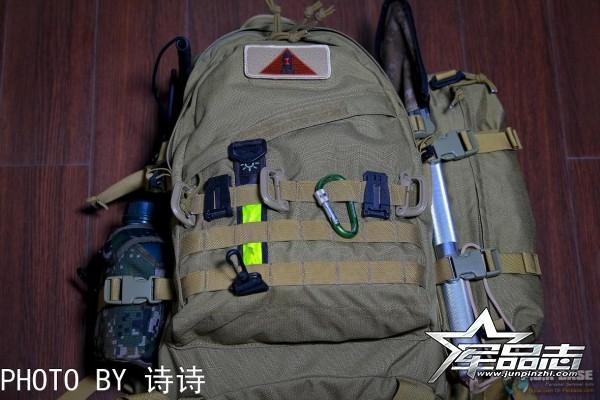
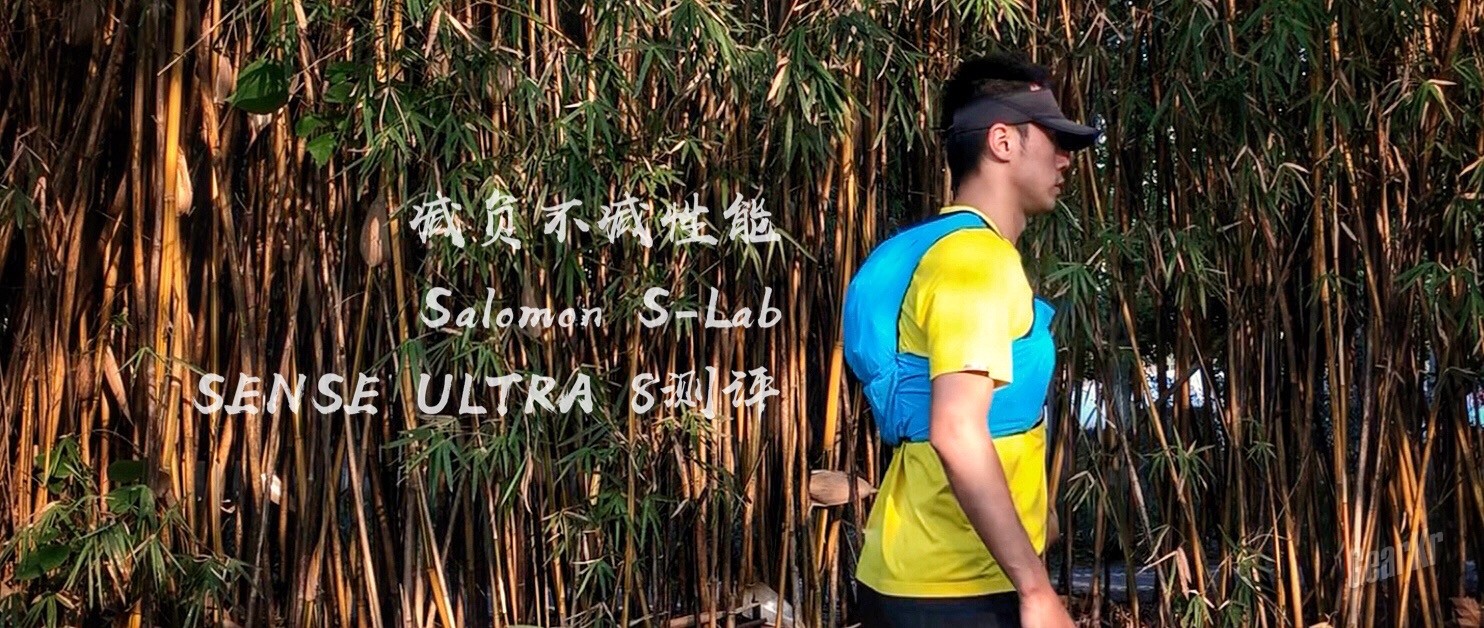


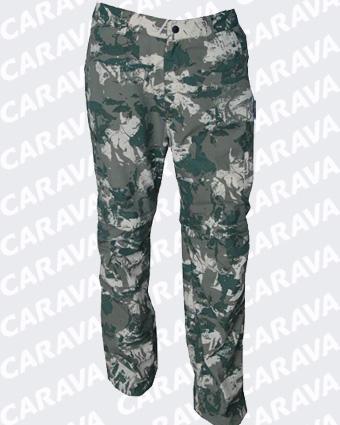




评论已关闭。